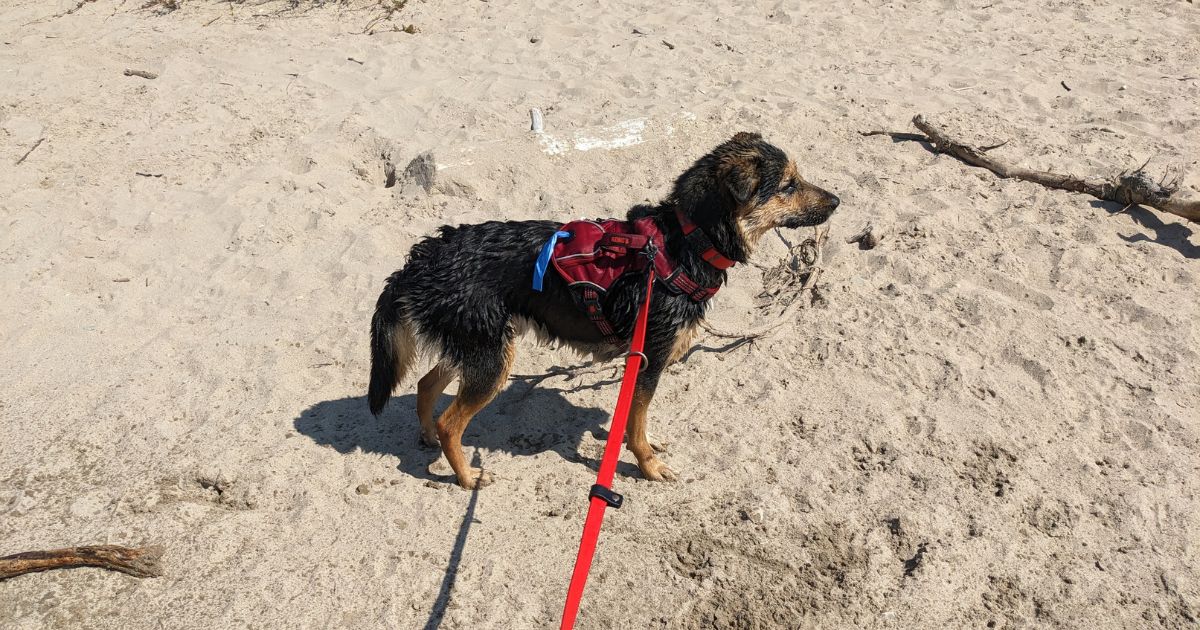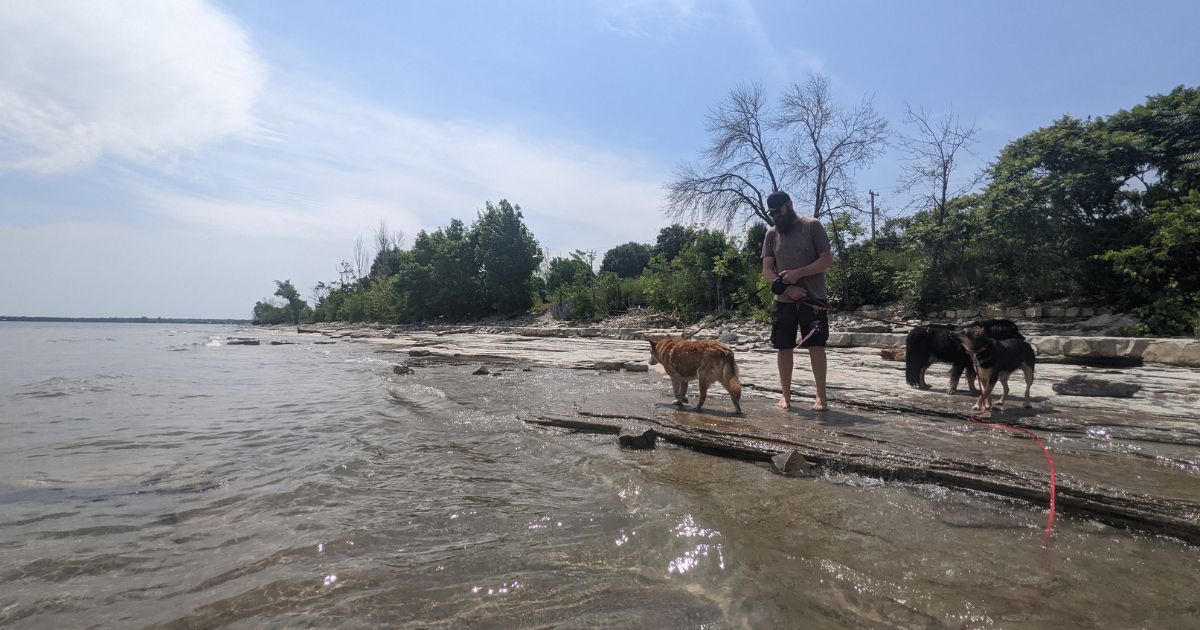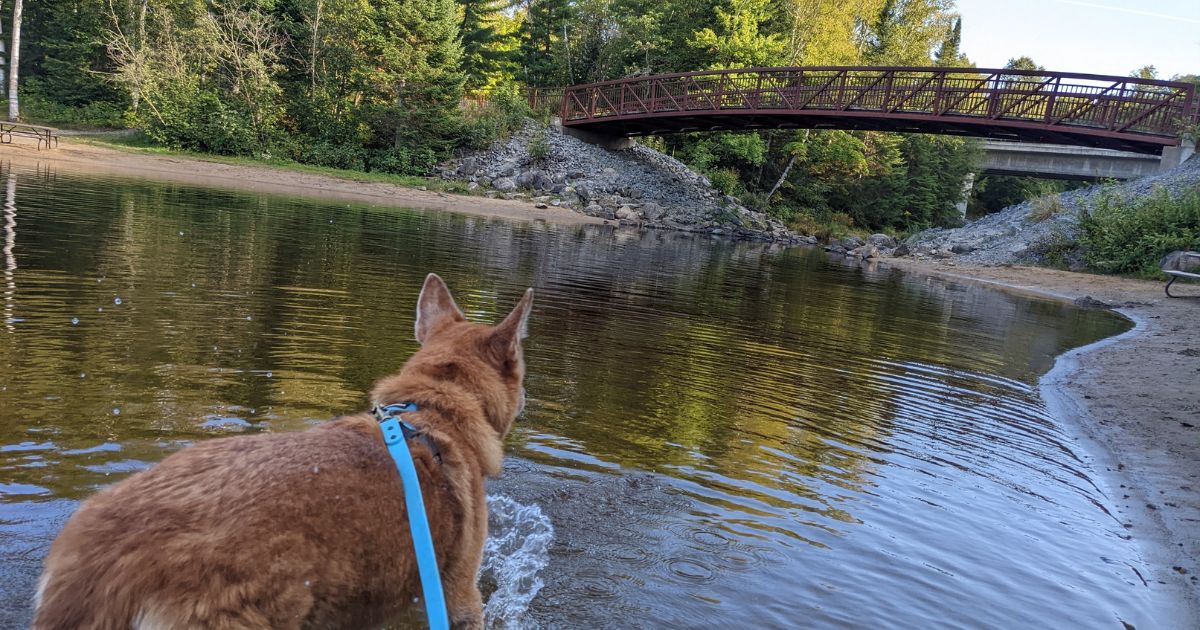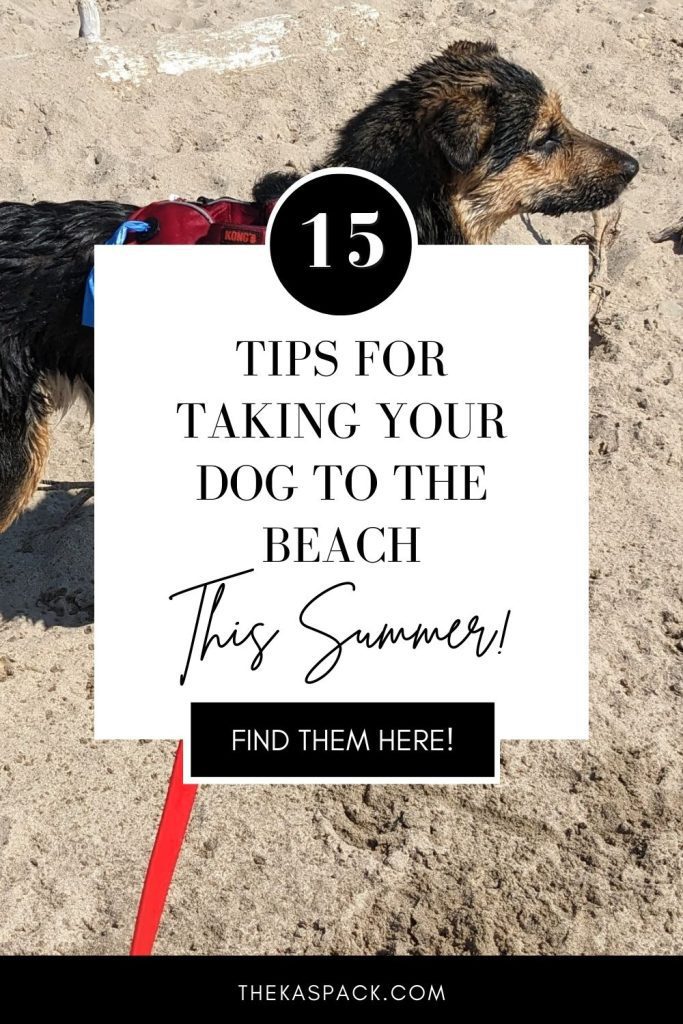15 Tips for Taking Your Dog to the Beach This Summer
For water-loving dogs like our girl Daviana, few activities are as exciting as a day at the dog beach. There is something so special about watching the excitement light up in her eyes the second she sees the lake in the distance.
However, safety should always be a top priority when taking your dog to the beach.
Whether this is your first time introducing your dog to the sand and surf, or you are an old pro looking for any new tips and tricks we have to share, this is for you!
As you plan your next beach getaway, here are a few helpful dog beach basics that you should consider…

This post contains affiliate links, which means if you click and buy, we will make a commission (at no cost to you). See my full disclosure policy for more details.
15 Tips for Taking Your Dog to the Beach
Research Your Beach Options
The first step to planning a fun pet-friendly beach day is to find a beach where your pets are welcome to run and play with you.
Depending on the destination, this may take some research on your end.
If you plan on visiting one of our provincial parks, you can check out our list of Dog Beaches & Exercise Areas at Ontario Parks as starting point. But don’t be afraid to branch out from there.
Consider checking beach areas nearby on trips with no dog beach within the park. For example, when camping at Wheatley Provincial Park, we love taking a day trip to Point Pelee National Park.
Pay Attention to Water Quality Warnings
While doing your research, take note of any water quality warnings that may be in place for the areas you are considering. Not only do these serve as a notice that the water isn’t safe for you to swim in, but it could also cause problems for your dog.
If the water quality alert in your area mentions blue-green algae, stay clear! These toxic algae blooms can be incredibly dangerous and even life-threatening.
Water quality alerts are often related to high bacteria levels, like E.coli, which can make your dog very sick. If you’re unsure, contact the public health unit for the region you plan to visit.
Learn the Laws and Restrictions
To abide by the law and restrictions in any location, you must first learn them. This includes understanding what areas your dog is permitted to swim, leash rules/where your dog is allowed off-leash, the maximum leash length, and more.
Keep in mind that these rules aren’t just in place to “control” or manage your dog.
Leash laws play an essential role in keeping everyone safe while allowing a wide range of people (and dogs) to enjoy the space.
Our beaches and trails should be accessible to everyone, but to do this, we must show one another respect. This means following the rules for each location.
No dog is above the rules. It doesn’t matter how “friendly” or “well trained” they are.
Check Your Pet’s ID
Before heading out, take a moment to double-check your dog’s ID tag. This goes beyond just checking that there is an ID tag on their collar.
Look closely at the tag to ensure it is still legible, as they can wear down over time. You should also verify that the information included on the tag is up to date.
Is your dog microchipped?
We kick off every season by checking in with the microchip company to ensure they have accurate contact information on file.
Pack a First Aid Kit
Accidents happen, regardless of how many precautions you take. Even the most responsible dog parents may find themselves in a situation where they must provide first aid care to their dog.
Some injuries or ailments your dog may suffer at the beach include:
- Broken nails
- Paw pad injuries
- Cuts and scrapes
- Injuries from fishing hooks or other foreign objects
- Injuries from other dogs
- Heat stroke or heat exhaustion
A standard human first aid kit will include most of the supplies needed to care for your dog, but it will fall short in some situations. Instead, we recommend packing a pet-friendly first aid kit with a few key additions, like styptic powder and vet wrap.
Bring Plenty of Fresh, Cool Water
One of the most important things you can pack for any adventure with your dog, especially during the summer heat, is drinking water.
We have had the opportunity to experiment with several different water bottle options and other products designed to make hydration a priority over the years.
Of these, there are two that we use regularly.
Note: Both of these products were gifted to us by the companies to try. But our opinions of the products are 100% our own.
- Spleash: A leash handle attachment that holds up to 12 fl oz of water with a fold-open cup for drinking and a spray option. The water spray can also be used as an effective deterrent if an off-leash dog approaches and refuses to recall.
- Lesotic Portable Dog Water Bottle: This bottle holds up to 14 fl oz in a bottle that can be clipped to your leash, belt buckle, or hiking pack with a convenient carabiner. It features a silicone bowl on the top to make drinking easy for your pup. It can also be purchased in larger sizes.
By having fresh water on hand, you can encourage proper hydration, prevent heat-related illnesses, and discourage your dog from drinking water that may be contaminated or unsafe.
Find or Create Shade
Another essential consideration to keep your dog cool and safe in the summer sun is to ensure they have shade throughout the day.
Often shaded areas can be found around the edges of a dog beach. If not, you may need to create your own shade. But pay careful attention to the rules regarding shelters and beach umbrellas.
With a growing number of people using the most popular beaches and locations, the demand for space is growing. As such, many places are placing limits or bans on larger sun shelters.
Instead, consider bringing a sport umbrella to create a patch of shade while still respecting the rules.
Pay Attention to Sand Temperatures
As the sun beats down on the sun, it can reach some alarmingly high temperatures. Walking across hot sand can cause burns and blistering on your dog’s paw pads.
Always check the temperature of the sand’s surface just as you would pavement before heading out for a walk.
Keep an eye on your dog’s paws throughout the day, watching for any sign of pain, blistering, or swelling that could indicate a problem.
Choose Safe Beach Toys
Sand impaction is a largely overlooked risk of taking a dog to the beach. This occurs when a dog swallows small amounts of sand that add up, creating a potentially life-threatening blockage.
Sand can be ingested in many ways, but one major culprit is your dog’s beach toys.
Tennis balls and toys with a similar felted or fabric surface can pick up large quantities of sand. When your dog picks the toy up to play, they inevitably swallow some of it.
Choosing toys with a rubber or smooth plastic exterior to reduce the amount of sand picked up during playtime.
Some of our favourite beach toys include the West Paw Zogoflex Huck (no longer available, but they have a new version of the ball: West Paw Zogoflex Jive) and the Chuckit Air Fetch Stick.
Rinse off your dog’s toys periodically throughout the day to prevent sand buildup.

Check for Litter or Debris
The beach sand is notorious for concealing hidden treasures. This is why it is such a popular spot for those with metal detectors to hunt for valuables.
But not everything hidden in the sand is a great discovery.
Keep an eye open for litter or debris that previous beachgoers may have left behind. This includes everything from broken glass that could cut your dog’s paws to discarded food that could tempt them and make them sick when ingested.
Take Regular Cool-Down Breaks
Is your dog constantly on the go with no sign of slowing down? If that sounds familiar, you’re not alone!
Whether you have a high-energy puppy or an older dog who refuses to act their age, like our senior girl Daviana, these active pups love being on the go. But they often need someone to enforce break times for their safety and well-being.
This is especially true if you are bringing a puppy to the beach, as they often have no understanding of their limits yet at this age.
Bring your dog into the shade to lie down and drink water periodically, allowing them to cool down and relax. If necessary, set an alarm on your phone as a reminder.
Teach Your Dog to Swim
If you are taking your dog to the beach for the first time, they may not have had the opportunity to learn to swim before.
Teaching your dog to swim can be a fun activity and a chance to strengthen your bond. Introduce the water slowly with plenty of reassurance, rewards, and praise.
Don’t rush this process. Moving out into deeper water before your dog feels comfortable taking that step can create fear and anxiety, preventing them from enjoying future beach adventures.
Consider Using a Life Jacket, if Needed
Until you are sure your dog is a confident swimmer, have them wear a life jacket anytime they are near a body of water, including during dog beach days.
Like a young child, it only takes a second for things to go badly.
Clean Up Behind You (Leave No Trace)
The “Leave No Trace” principles are wildly accepted among outdoor travellers. They are guidelines designed to encourage responsible and ethical outdoor adventures.
While these principles are usually discussed concerning human travellers, they also apply to travelling with your dog.
When visiting the beach, leave nothing behind but paw prints. This means cleaning up your dog’s waste and disposing of all garbage appropriately.

Rinse Well and Finish with a Bath (If Needed)
When your beach day is coming to an end, take a moment to rinse your dog off, if possible. This removes any sand or other irritants that could have collected in their coat.
If you don’t have clean water for a rinse, you can wipe your dog down with a towel to remove loose sand until you get your dog home for a proper rinse.
Dogs with overly sensitive skin or those that are prone to experiencing irritation may need a full bath after every beach excursion. A bath is also recommended if there is any possibility that your dog was exposed to something concerning, like algae.
Final Thoughts: Taking Your Dog to the Beach
A successful beach trip with your dog starts with careful planning and preparation. To begin, ask yourself, “Are dogs allowed on beaches in this area?”
If the answer is no, keep searching until you find an acceptable dog-friendly location.
Leading up to your trip, make sure that you pack everything you may need, including a fully stocked pet first aid kit, plenty of fresh water, a beach umbrella for shade, and safe beach toys.
Always supervise your dog carefully, staying alert for potential risks and stepping in to enforce regular cool-down breaks.
Most importantly, have fun! Celebrate the summer and make lasting memories with your furry best friend.

Do you have any advice for safely taking your dog to the beach that we missed? If so, we’d love to hear it in the comments!
